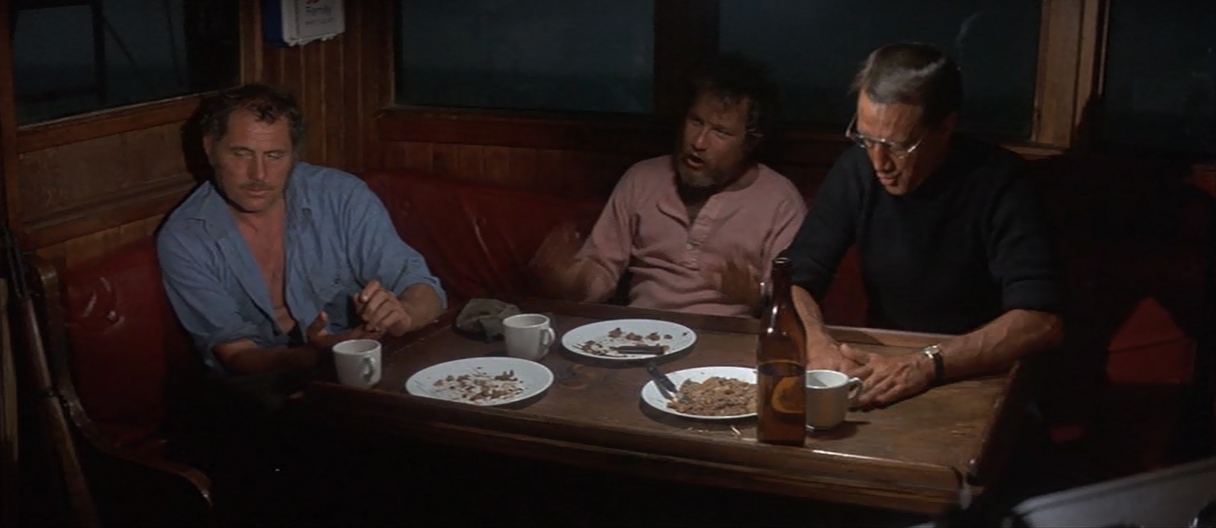Jaws | Directed by Steven Spielberg // Starring Roy Scheider, Robert Shaw, Richard Dreyfuss, Lorraine Gary, and Murray Hamilton
Set the mood with some music!
Summary (Spoiler-free): Set in the small beach town of Amity Island, Jaws follows a police chief, a marine biologist, and a grizzled shark hunter who set out to stop a monstrous great white shark that’s terrorizing the coast.
Let’s get one thing straight: Jaws is more than a shark movie. It’s a near-perfect film. And yeah, I know that sounds hyperbolic, but the more I rewatch it, which is literally every time it's on TV, the more I believe it. I’ve loved this movie since I was a kid — the suspense, the characters, the one-liners, the sheer fun of it. But now, having learned more about film and its history, I love it on an entirely new level. This thing was a disaster behind the scenes. A young Steven Spielberg, still earning his stripes, was thrown into the deep end (literally and figuratively), battling a malfunctioning mechanical shark, a punishing shooting schedule, and a studio that was losing confidence by the day. And somehow? He made a masterpiece.
The beauty of Jaws lies in how those production nightmares became its greatest strength. The shark didn’t work most of the time — so Spielberg leaned into suggestion. We see ripples in the water, floating barrels, sudden music cues. And that made it all so much scarier. The audience had to use their imagination, and that’s always more terrifying than what you can show. It’s the kind of accidental brilliance that only comes from making do with what you have. And Spielberg didn’t just “make do” — he invented an entire playbook for suspense.
Steven Spielberg’s direction is nothing short of masterful — all the more impressive considering how young he was at the time. This wasn’t just a filmmaker with technical chops; this was someone who understood suspense, pacing, character, and how to move an audience. And he was doing it with a malfunctioning mechanical shark, a crew ready to mutiny, and a studio breathing down his neck.
What Spielberg pulled off here is the blueprint for how to build tension. He took a broken shark and turned it into a stroke of genius. By not being able to show the creature, he was forced to suggest it — through sound, camera movement, editing, and the reactions of the characters. He instinctively knew that what the audience imagines is always more frightening than what they see. The result? Some of the most iconic, nail-biting sequences in cinema history. You don’t see the shark in full until nearly halfway through the film, and by then, Spielberg has already established it as the most terrifying thing imaginable.

He also treats his characters — and the town of Amity — with incredible care. There’s a naturalism to the way people talk, move, and react. Spielberg lingers on little human moments: kids on the beach, Brody flipping through shark books at the dinner table, a mother slapping a police chief out of grief. These aren't just filler — they ground the horror in a place that feels painfully real. It’s a shark movie, yes, but it’s also a story about community, responsibility, and fear of the unknown.
The second half of the film, thought, becomes an entirely different beast. Once we’re out at sea, Jaws becomes intimate, almost theatrical. It’s just three men, a boat, and something in the water. Spielberg stages these scenes with precision, knowing exactly when to break the tension with humor, when to let things breathe, and when to slam on the gas. His use of the camera — sometimes shaky handheld, sometimes locked down and wide — always serves the moment. He knows exactly when to show and when to withhold.
There’s a confidence in Spielberg’s direction here that feels decades beyond his age at the time. It’s not flashy. It’s not overly stylized. But it is alive with purpose. Every frame serves the story. Every shot builds mood. Every choice, whether forced by circumstance or driven by instinct, helps shape the masterpiece that Jaws became.
The performances are pitch-perfect. Roy Scheider gives us a grounded, relatable everyman as Chief Brody. Richard Dreyfuss is sharp and energetic as the oceanographer Hooper. And Robert Shaw… my god. Quint is one of the greatest characters ever put to screen. Gruff, haunted, oddly poetic. That monologue about the USS Indianapolis? Legendary. It sends chills down your spine every single time.
John Williams’ score might be the most iconic in film history. Two notes. That’s all it takes. Two simple notes, and your pulse spikes. But it’s not just the main theme — the entire score is brilliant, bouncing between ominous dread and adventurous spirit, helping to shape the tone in every scene.
And then there’s the editing, the cinematography, the sound design — all working together in perfect harmony. You feel the water. You feel the isolation. You feel the danger. Jaws doesn’t need flashy effects or modern CGI. It has atmosphere. It has craft. It has heart.
Jaws is one of those rare films that’s both important and beloved. It launched the summer blockbuster, proved Spielberg was a generational talent, and terrified people so deeply that beach attendance dropped for years. But beyond all that, it’s just a great movie. Entertaining, smart, scary, and endlessly rewatchable. It has flaws, sure, but those flaws are part of what make it so special. They’re part of its DNA. When I think about why I love movies — not just as entertainment, but as experiences — I think of Jaws.